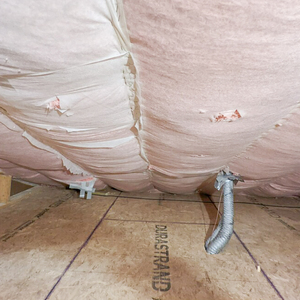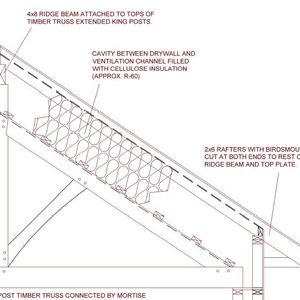
Modulerics’s New Jersey home has a poorly insulated vented attic that he would like to update. Roughly half the attic is over a ceiling of joists and drywall, but in the master bedroom, the vaulted ceiling consists of tongue-and-groove boards supported by heavy timber joists.
Before Modulerics adds more insulation to the area over the vaulted ceiling, he first needs to seal the tongue-and-groove ceiling against air leaks.
“So in the attic I’ve got a this whole area flat, no joists to work around,” he writes in this recent Q&A post. “It currently has R-11 batts on top of it. I want to blow insulation in the whole attic. What’s the best way to air-seal the-tongue-and groove section?”
Among the options he sees is removing the insulation that’s already there and stapling or cap-nailing down a layer of Tyvek housewrap and taping the seams.
“It’s a low-slope roof, if that means anything,” Modulerics adds. “If I remove the batts, I should not reinstall them so I don’t trap moisture between the batting and the air barrier I put down, correct? Should I build dams and blow in cellulose?”
Or, Modulerics continues, he might simply add the housewrap over the batts already in place, creating what he calls “one big pillow,” and salvage whatever R-value the batts are providing.
That’s his situation. What should he do? That’s the question for this Q&A Spotlight.
Skip the housewrap
Zephyr7 suggests two alternatives. One is to remove the batt insulation and then spray a thin layer of polyurethane foam over the exposed tongue-and-groove boards. The other approach would be to use sheets of rigid-foam insulation sealed at the perimeter with canned spray foam, a method called “cut-and-cobble.”
Spray foam is expensive, and…
Weekly Newsletter
Get building science and energy efficiency advice, plus special offers, in your inbox.

This article is only available to GBA Prime Members
Sign up for a free trial and get instant access to this article as well as GBA’s complete library of premium articles and construction details.
Start Free TrialAlready a member? Log in















3 Comments
Another approach: install drywall on the room side. Avoids the poor quality work that comes with working in cramped spaces. Embrace a new aesthetic and a brighter ceiling.
Question about the last two paragraphs -- the penultimate paragraph recommends a vapor-closed air barrier, and the last paragraphs suggests peeling off the vapor retarder. Why wouldn't you just lay the batts with the vapor retarding side faced down, since you just added a vapor barrier at that location anyway?
Why not a fluid applied air barrier that ca be painted on? It ought to be able to be brushed into pretty well all of the books and crannies. It would be easy to get into the attic and as long as you start in the far point and paint your way out it would be easy to install. Then put whatever insulation you want on top of it.
Log in or become a member to post a comment.
Sign up Log in